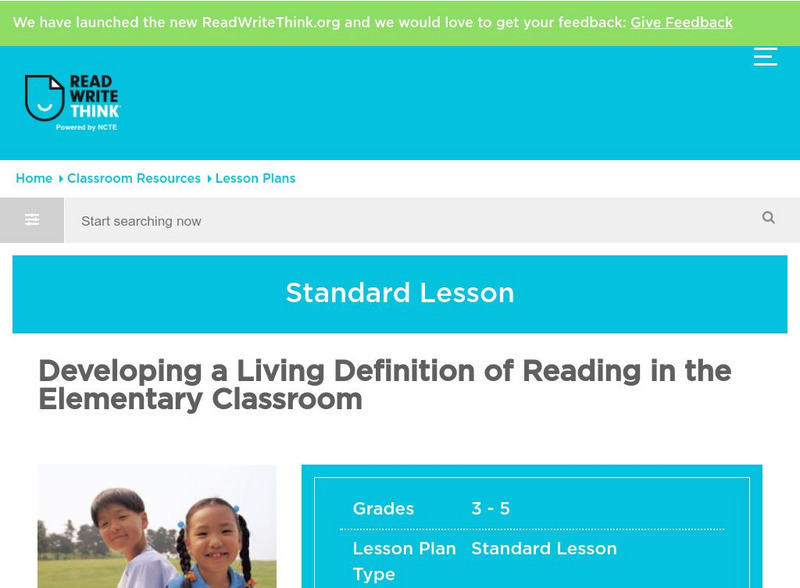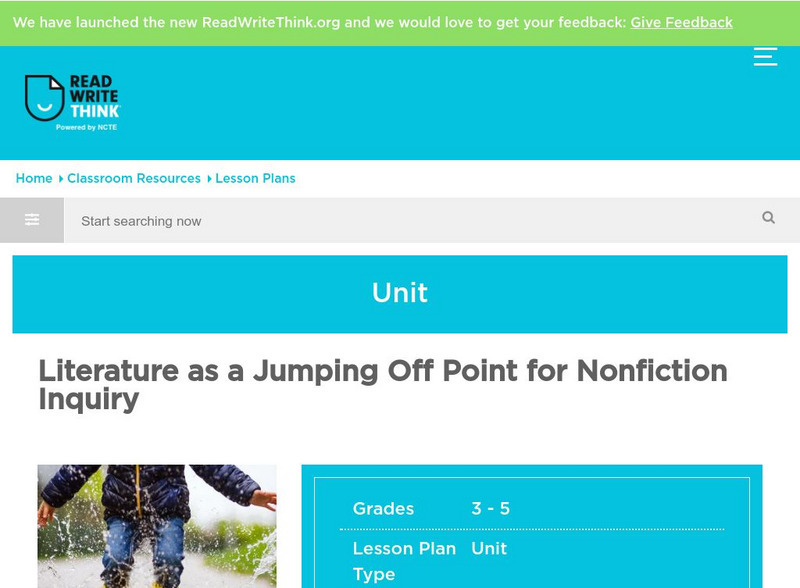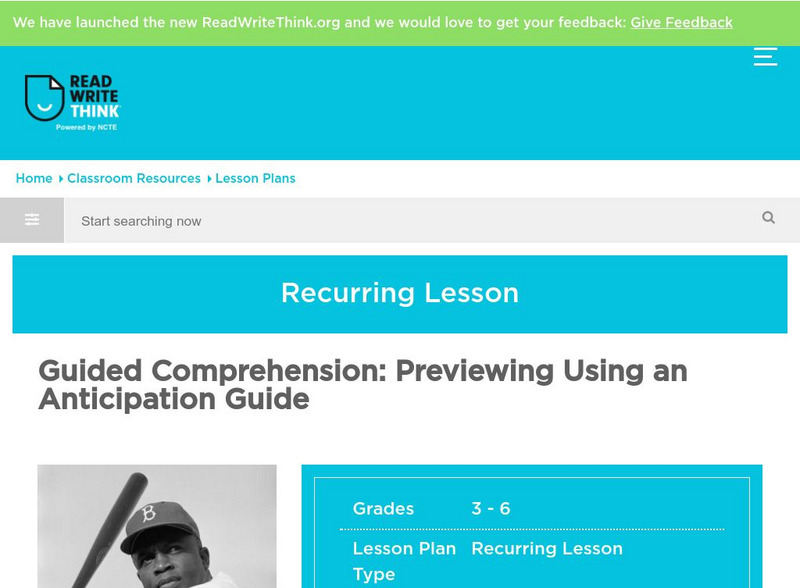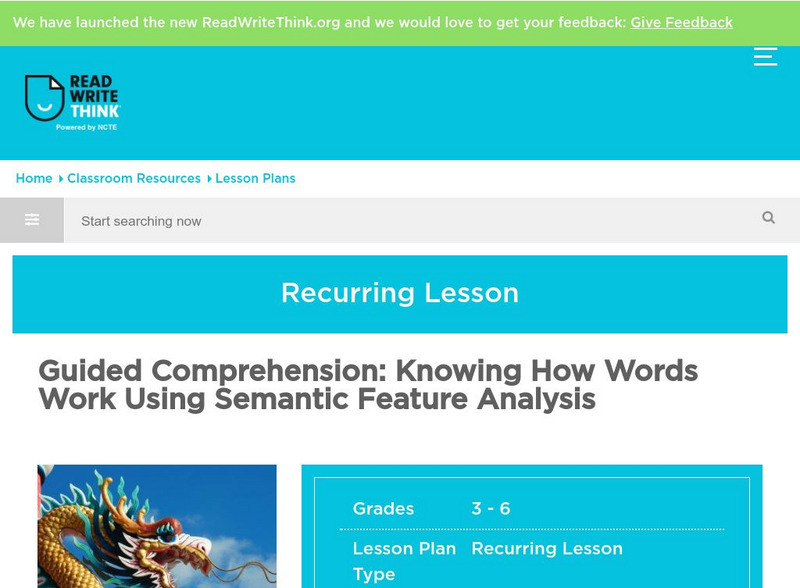Curated OER
Mc Graw Hill: Part 2 Reading: Informational Text: Cause and Effect Text Structure
Cause and Effect is a text organization structure and knowing this structure can help you in comprehending a text. Learn about these strategies on this site.
Read Works
Read Works: "Lon Po Po" and "A Tricky Monkey"
[Free Registration/Login Required] Students will read "Lon Po Po" and "A Tricky Monkey" and answer comprehension questions based on these fictional stories. This unit meets multiple Common Core Reading Standards for 3rd-grade literature.
Curated OER
Mc Graw Hill: Part 2 Reading: Informational Text: Show Understanding of Text
This quick activity includes a passage from an information text, and explains reading comprehension strategies to use to answer questions.
Other
Reading Educator: Question Answer Relationships
Based on the presumption that every teacher shares responsibility for teaching reading, this page offers a brief look at question-answer relationships, as well as suggestions for putting the strategy to use in the classroom.
ReadWriteThink
Read Write Think: K W L S Chart
A printable K-W-L-S sheet to help students activate prior knowledge, ask questions, record new learning, and then ask additional questions to extend inquiry beyond the text . Directions on how to use this type of graphic organize as well...
ReadWriteThink
Read Write Think: Developing a Living Definition of Reading in the Elementary
Using the guiding question, "What is reading?" students interact with a variety of texts as they uncover the skills necessary to interact with texts and develop a definition of reading.
ReadWriteThink
Read Write Think: Literature in Nonfiction Inquiry
This lesson plan involves students working in groups after reading a work of literature to develop text sets. Included in the lesson plan is an overview, practice, objectives, resources, preparation, and more.
ReadWriteThink
Read Write Think: Guided Comprehension: Previewing
This lesson introduces students to the comprehension technique of previewing. Students use anticipation guides to preview and predict stories and work in small groups.
ReadWriteThink
Read Write Think: Guided Comprehension: Making Connections
Lesson introduces young scholars to the strategy of making connections. Students learn the three types of connections using a double-entry journal. A good resource for teachers.
ReadWriteThink
Read Write Think: Exploring How Section Headings Support Understanding
Teaching students to pay attention to headings and titles as they read? Here you'll find a practical application for using an expository text to apply the concept of using headings. Geared toward older elementary students, but lesson...
ReadWriteThink
Read Write Think: Guided Comprehension: Semantic Analysis
Lesson introduces learners to comprehension of knowing how words work. Students learn semantic feature analysis and examine folktales, myths, and fables using this analysis to better understand these terms and texts.
ReadWriteThink
Read Write Think: Guided Comprehension: Evaluating
This lesson introduces students to the comprehension strategy of evaluating. Students learn this strategy through the "meeting of the minds" technique that teaches them to act out opposing views of two or more characters.
ReadWriteThink
Read Write Think: Applying Question?answer Relationships to Pictures
Contains plans for two lessons that develop students' ability to ask questions about the pictures in a text. In addition to objectives and standards, this instructional plan contains links to sites used in the lessons as well as...
ReadWriteThink
Read Write Think: Depend on the Text! How to Create Text Dependent Questions
This strategy guide focuses on writing text-dependent questions which require the student to reread the text to support their answers. It offers a list of what to do to create these questions that progress from establishing general...
ReadWriteThink
Read Write Think: Guided Comprehension: Self Questioning
Online lesson introduces students to the concept of self-questioning, assisting them in an understanding of question-answer relationships that should improve their reading comprehension skills. In-depth study will lead to improved...
ReadWriteThink
Read Write Think: Guided Comprehension: Summarizing
Lesson that introduces students to the comprehension technique of summarizing. Students learn using the QuIP (questions into paragraphs) method which involves organizing information and putting it in writing.
US Department of Education
U.s. Dept. Of Education: Teaching Approaches: Text Comprehension Instruction
What is text comprehension? How does comprehension improve our reading ability? Check out this site to learn more about reading comprehension instruction. There are some wonderful suggestions for teachers to implement in their classrooms.
Tom Richey
Slide Share: Making Connections
A slide show with thirty-two slides explaining how to use text to self, text to text, and text to world connections to improve reading comprehension.
Read Works
Read Works: Should Students Pay to Play?
[Free Registration/Login Required] This passage is a stand-alone curricular piece that reinforces essential reading skills and strategies and establishes scaffolding for vocabulary learning. It contains questions and teacher guides and...
Read Works
Read Works: Light Bounces!
[Free Registration/Login Required] An informational text about light waves and how they travel. A question sheet is available to help students build skills in reading comprehension.
Read Works
Read Works: Whoop It Up!
[Free Registration/Login Required] An informational text that asks the reader to make predictions about s scientist who work to teach cranes to migrate. A question sheet is available to help students build skills in reading comprehension.
Other
Thinkport.org: Monitor Comprehension
A resourceful site explaining, chronicling, and detailing the idea of students' monitoring their own comprehension of a task or understanding. Includes a video link, quotes from experts, links, and more.
Other
Into the Book: Questioning
Learn the significance of questioning in the classroom to teach students how to question the text in order to better understand what they are reading.
Curated OER
Mc Graw Hill: Part 2 Reading: Informational Text: Reasons and Evidence in Text
An article discussing how authors use reasons and evidence to support their ideas in a text. Site includes an example to help students find reasons and evidence.

























